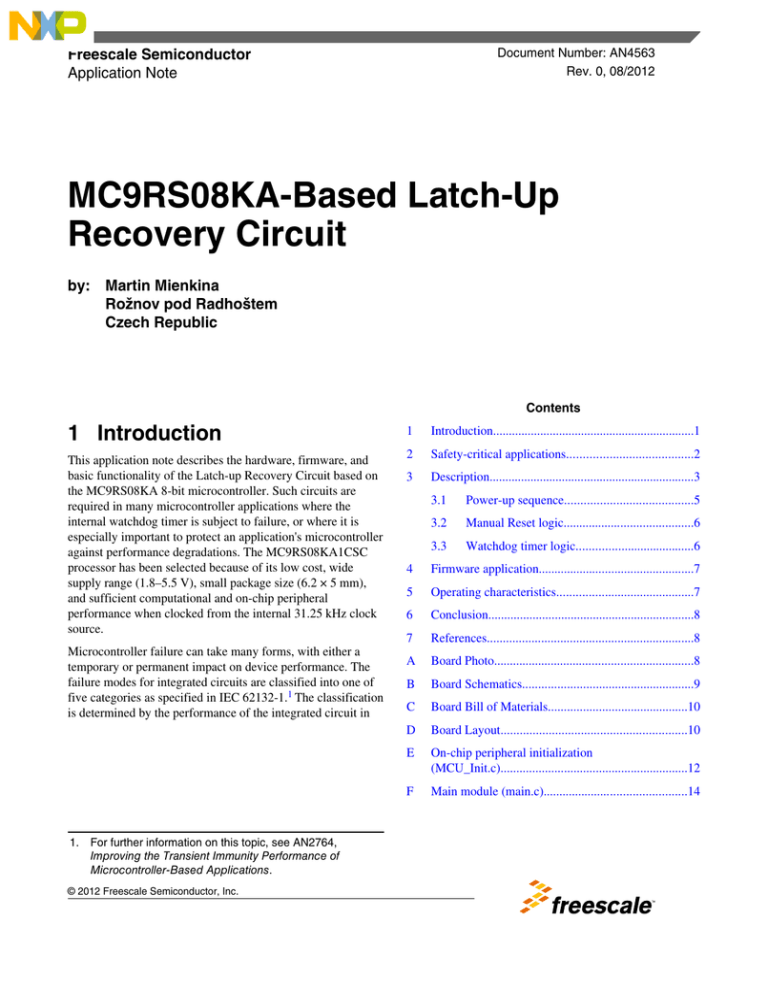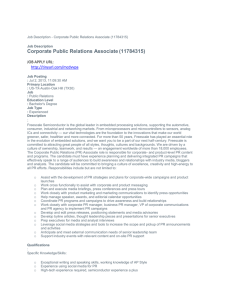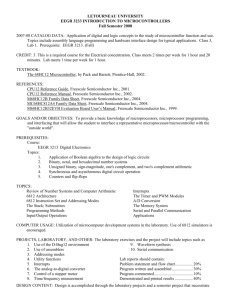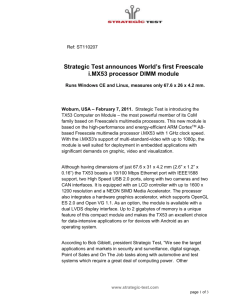
Freescale Semiconductor
Application Note
Document Number: AN4563
Rev. 0, 08/2012
MC9RS08KA-Based Latch-Up
Recovery Circuit
by:
Martin Mienkina
Rožnov pod Radhoštem
Czech Republic
Contents
1 Introduction
1
Introduction................................................................1
This application note describes the hardware, firmware, and
basic functionality of the Latch-up Recovery Circuit based on
the MC9RS08KA 8-bit microcontroller. Such circuits are
required in many microcontroller applications where the
internal watchdog timer is subject to failure, or where it is
especially important to protect an application's microcontroller
against performance degradations. The MC9RS08KA1CSC
processor has been selected because of its low cost, wide
supply range (1.8–5.5 V), small package size (6.2 × 5 mm),
and sufficient computational and on-chip peripheral
performance when clocked from the internal 31.25 kHz clock
source.
2
Safety-critical applications.......................................2
3
Description.................................................................3
Microcontroller failure can take many forms, with either a
temporary or permanent impact on device performance. The
failure modes for integrated circuits are classified into one of
five categories as specified in IEC 62132-1.1 The classification
is determined by the performance of the integrated circuit in
1.
For further information on this topic, see AN2764,
Improving the Transient Immunity Performance of
Microcontroller-Based Applications.
© 2012 Freescale Semiconductor, Inc.
3.1
Power-up sequence........................................5
3.2
Manual Reset logic.........................................6
3.3
Watchdog timer logic.....................................6
4
Firmware application.................................................7
5
Operating characteristics...........................................7
6
Conclusion.................................................................8
7
References.................................................................8
A
Board Photo...............................................................8
B
Board Schematics......................................................9
C
Board Bill of Materials............................................10
D
Board Layout..........................................................10
E
On-chip peripheral initialization
(MCU_Init.c)...........................................................12
F
Main module (main.c).............................................14
Safety-critical applications
the presence of the ESD or EFT signal. Freescale’s interpretation of the IEC failure modes, and those performance classes
specific to microcontrollers, is shown in Table 1.
Table 1. Freescale classification of microcontroller performance degradation
Class
Description
A
Normal performance within the specification limits during application of the transient.
B
Temporary degradation or loss of function or performance that is self-recoverable after the transient is
removed. Device returns to normal performance.
C
Temporary degradation or loss of function or performance that requires an external reset after the transient
is removed. Device returns to normal performance.
D
Temporary degradation or loss of function or performance that requires that power be cycled after the
transient is removed. Device returns to normal performance.
E
Permanent degradation or loss of function that is not recoverable due to damage or loss of data.
Common forms of microcontroller temporary degradation include, but are not limited to: internal reset, latch-up, memory
corruption, and code runaway. Microcontrollers with internal reset circuits can generally resume operation without operator
involvement if the fault is a software failure, an unexpected reset, or a code runaway that is caught by the watchdog timer. A
transient event such as a Powered ESD, EFT, or overshoot or undershoot on a pad, may cause failures of the state machines
and nodes of the microcontroller critical to reset recovery or CMOS latch-up. These particular failures are only reset by a
Power-on Reset (POR), so if state machines and nodes critical to reset recovery fail, or if the device is in a CMOS latch-up
state, characterized by a high sustained current, the device’s only recovery is to reduce the voltage below the POR threshold,
usually by removing power from the device. The Latch-up Recovery Circuit has been designed to guarantee the successful
recovery of the monitored processor from a latch-up state. In general, it should be used in any safety-critical application
where achieving a higher reliability of microcontroller operation is necessary.
2 Safety-critical applications
Figure 1 shows a typical signal interconnection of the Monitored Processor with the Latch-up Recovery Circuit in a safetycritical application. The Latch-up Recovery Circuit is intended to recover the Monitored Processor from the failure modes
Classes B, C, and D by reducing the supply voltage below the POR threshold (power cycling). In addition, it improves the
reliability of the application by its external reset and supply monitoring functions.
Manual
reset
RESET/VPP
Supply
voltage
BKGD/MS
VDD
VSS
Latch-up
Recovery
Circuit
MR
WDI
PWR
VDD Monitored
VSS
VSS
Processor
Output
Figure 1. Typical safety-critical application
The Latch-up Recovery Circuit is based on the MC9RS08KA1 microcontroller.2 This standalone circuit enhances the
reliability of the microcontroller-based application by providing external monitoring and recovery functions. The circuit is
comprised of two input control signals which are supposed to be handled deterministically by the Monitored Processor. The
first signal, the watchdog input (WDI), must be toggled periodically and any failure to change the state of the signal prior to a
2.
For more information on this chip, see MC9RS08KA2, MC9RS08KA2, MC9RS08KA1 Data Sheet.
MC9RS08KA-Based Latch-Up Recovery Circuit, Rev. 0, 08/2012
2
Freescale Semiconductor, Inc.
.
Description
watchdog timeout, "tWD," will always result in a processor POR. The second signal, the manual reset input (MR), can be
directly attached to a push-button or a processor open-drain output pin. Whenever the MR pin is pulled low, the Monitored
Processor becomes unpowered.
Besides the mentioned recovery functions, the Latch-up Recovery Circuit continuously monitors the supply voltage (VDD)
and keeps the Monitored Processor unpowered until that voltage reaches the MC9RS08KA1 threshold.
3 Description
The figure below shows a block diagram and the signal interconnections of the MC9RS08KA1 Based Latch-up Recovery
Circuit. The Freescale MC9RS08KA1CSC microcontroller (U1), P-channel MOSFET (Q1) and N-channel MOSFET (Q2)
are the main components of the circuit (for a complete component list, refer to the schematic diagram in Board Schematics
and the bill of materials in Board Bill of Materials). The functions of the pins are listed in Table 2.
R4 10k
RESET/VPP
MR
PTA5
R1
10k
U1
1
BKGD/MS
2
R6 390
VDD
3
C1
10u
C2
100n
4
RESET/VPP
PTA0
BKGD/MS
PTA1
MC9RS08KA1
VDD
VSS
LVD COP
POR CPU
PTA4
PTA5
Q1
P-FET
PTA4
8
7
6
5
R5
10k
PTA4
PTA5
WDI
pull-up
Q2
N-FET
R3
390k
WDI
PWR
R2
10k
VSS
VSS
Figure 2. Block diagram of the MC9RS08-based Latch-up Recovery Circuit
Table 2. Latch-up Recovery Circuit pin functions
Pin name
Function
RESET/VPP
Reserved for device programming.
BKGD/MS
Reserved for device programming.
VDD
Power supply from 1.8 to 5.5 V. Integrates a 10μF bulk capacitor (C1) to supply instantaneous energy to
the external watchdog circuit, and a 0.1μF bypass ceramic capacitor, located as close to the MC9RS08KA1
power pins as practical, to suppress high-frequency noise. The integrated 390Ω resistor (R6) improves the
immunity of the microcontroller device against voltage transients.
VSS
Ground
PWR
Power supply for the monitored processor.
MR
Manual Reset Input. Pulled high by the MC9RS08KA1 internal pullup resistor (~45kΩ). This pin is designed
to be driven low externally either by a mechanical push-button or an open drain output.
WDI
Watchdog Input to be driven by a Monitored Processor output. The monitoring function may be disabled
(watchdog function blocked) by tristating or leaving this pin open. The watchdog timeout is defined by the
“tWD” parameter and equals 500 ms by default.
Table 3 below describes the logic dependencies of the internal signals on the control inputs. Note that pin PTA5 of the
MC9RS08KA1 is configured either in input mode (with an internal ~45kΩ pullup resistor) or in push-pull output mode. The
input mode is active whenever a Manual Reset Input (MR) and Watchdog Input (WDI) are detected. The latter, push-pull
output mode is applied to detect the tristate mode of the Watchdog Input (WDI). Note that whenever the WDI pin is in
MC9RS08KA-Based Latch-Up Recovery Circuit, Rev. 0, 08/2012
Freescale Semiconductor, Inc.
3
Description
tristate mode, and the “WDI pullup” jumper is also opened, the watchdog timer logic is disabled. It is recommended that you
close this jumper during normal operation in order to keep the watchdog logic permanently enabled and running. On the other
hand, leaving this jumper opened during software upload, debugging, and low power mode testing might be advantageous in
preventing power cycles when either the WDI pin is in tristate mode or not handled by the Monitored Processor.
Table 3. Truth table
State
Control inputs
WDI
MR
MC9RS08KA1 I/O signals
WDI jumper
PTA4 (input mode—tristate)
PTA5 (see mode below)
Watchdog and manual reset logic—PTA5 configured to input mode with an internal pullup
1
0
2
1
3
0
4
1
5
tristate
6
1
x
0
1
1
0
0
0 (manual reset)
1
1
0
7
1
open
0
close
1
0 (manual reset)
Watchdog disable (WDI tristate detection)—PTA5 configured in push-pull mode
8
1
9
0
10
tristate
x
x
1
x
0
1
1
11
open
0
0
12
close
1
Figure 3 shows the logic tasks executed by the Latch-up Recovery Circuit after a Power-on Reset. The firmware execution
starts with a power-up sequence that executes after a POR or COP reset. Following the initial power-up sequence, the main
firmware loop starts to execute. Two logic functions, Manual Reset logic and watchdog timer logic, run inside the main loop
on a periodic basis. A detailed description of the firmware initial sequence and logic functions is given in the following
sections.
MC9RS08KA-Based Latch-Up Recovery Circuit, Rev. 0, 08/2012
4
Freescale Semiconductor, Inc.
Description
Power-on reset
COP Reset
Power-up
Sequence
MR
MR= 0
MR=HiZ or 1
no
MTIMCNT
>
“tPO”
yes
PWR OFF
PWR ON
Manual Reset
Logic
MR
MR= 0
MR=HiZ or 1
Watchdog Timer
Logic
WDI
WDI=E or (HiZ &
“WDI pull-up” opened)
WDI=”0" or “1” or (HiZ &
“WDI pull-up” closed)
yes
MTIMCNT
>
“tWD”
MTIMCNT
=0
no
Figure 3. Modes of operation
3.1 Power-up sequence
When the supply voltage (VDD) is initially applied to the Latch-up Recovery Circuit (MC9RS08KA1), or when the supply
voltage (VDD) drops below the VPOR, typically 1.4 V, the internal power-on reset circuit will cause a reset condition.3 As
the supply voltage (VDD) rises, the internal low-voltage detection circuitry still holds the device in reset until the supply has
risen above the VLVD, typically 1.95 V. Until the supply voltage (VDD) rises to the VLVD level, typically 1.95 V, the
microcontroller pins are in tristate mode. Whenever PTA0 and PTA1 are tristated, the external pullup resistor (R1) and
external pulldown resistor (R2) cause the P-channel (Q1) and N-channel (Q2) MOSFETs to be turned off; thus, the supply
voltage (PWR) for the Monitored Processor is not applied (see Figure 4).
When the supply voltage (VDD) rises above the VLVD trip point, typically 1.95 V, the system reset terminates and the CPU
starts to execute the initial power-up sequence. Firstly, the startup code executes and all necessary on-chip peripherals are
initialized (see On-chip peripheral initialization (MCU_Init.c) for additional information). Secondly, firmware processes the
Manual Reset Input (MR). If MR input is pulled high, the software execution stalls until the Modulo Timer (MTIM) reaches
a user defined power-off timeout, “tPO.” Finally, the supply voltage (PWR) is applied to the Monitored Processor by turning
on the P-channel (Q1) and turning off the N-channel (Q1) MOSFETs.
3.
For futher information, see MC9RS08KA2, MC9RS08KA2, MC9RS08KA1 Data Sheet and AN3394, Resetting
MC9RS08KA During Power Transitions.
MC9RS08KA-Based Latch-Up Recovery Circuit, Rev. 0, 08/2012
Freescale Semiconductor, Inc.
5
tPO
time
Description
Supply
voltage
VLVD
PWR
tPO
time
Figure 4. Power-up sequence
3.2 Manual Reset logic
The Latch-up Recovery Circuit has a Manual Reset (MR) input to allow for alternative control of the P-channel and Nchannel MOSFETs. The MR input is designed for direct connection to a push-button (see Figure 1). The MR input is
internally pulled up by a ~45kΩ resistor and must be pulled low to cause the P-channel MOSFET to turn off. Internally, this
input is timed such that the power supply for the Monitored Processor (PWR) is not applied for a minimum power-off
timeout, “tPO.” This power-off timeout, “tPO,” is user-programmable and may be set from 16 to 2000 ms (8 ms resolution).
The circuit interaction when the MR control input is pulled low by pressing a push-button is shown in the figure below.
MR
PWR
tPO
time
Figure 5. Manual reset
3.3 Watchdog timer logic
The watchdog timer logic forces the P-channel MOSFET to turn off whenever the WDI input does not have a transition from
low-to-high, or high-to-low, within the watchdog timeout, “tWD.” The watchdog timer logic starts to operate immediately
after the Power-up sequence (see Power-up sequence). If a transition occurs on the WDI input pin prior to the watchdog
timeout, “tWD,” the watchdog timer resets and a new counting begins. When the watchdog timer overflows, then the Pchannel MOSFET is turned off for a minimum power-off timeout, “tPO.” The watchdog timeout, “tWD,” is userprogrammable and may be set from 16 to 2000 ms (8 ms resolution).
Figure 6 shows the WDI control signal transitions in a typical safety critical application (see Figure 1). Any processor signal
that repeats dependant on the normal operation of the processor, or that is directed by the software operating on the processor,
can be used to strobe the watchdog input (WDI). The most reliable is a dedicated I/O output transitioned by a specific
software instruction.
MC9RS08KA-Based Latch-Up Recovery Circuit, Rev. 0, 08/2012
6
Freescale Semiconductor, Inc.
Firmware application
WDI
tri-state
mode
PWR
>tPW >tPW
tWD
tPO
time
Figure 6. Watchdog timer logic
The watchdog timer logic can be disabled by placing the WDI input in tristate mode while leaving the “WDI pullup” jumper
opened. The WDI pin is periodically pulled high/low via resistor R3 by the PTA5 pin, which is reconfigured by the firmware
to the push-pull output mode for that specific purpose. If the Monitored Processor places the WDI signal into tristate mode,
then the WDI pin tightly follows the states of the PTA5 pin, which is pulled low, then pulled high and low again by the
firmware. Such a tight coupling of the PTA4 (WDI) input states with the PTA5 forced state transitions shows that the WDI
pin is in tristate mode and, thus, the watchdog timer logic may be disabled. This sequence runs periodically but the tristate
mode is not detected when the WDI input is driven high or low by the Monitored Processor and/or the “WDI pullup” jumper
is closed (see Table 3, states 8–12).
4 Firmware application
The application firmware was developed using the CodeWarrior Development Studio for Microcontrollers V6.3. The high
level language (C-language) and also the Device Initialization Tool were used intentionally for firmware development to
make the source code simple, understandable, and easy to modify. The source code for initialization of all on-chip peripherals
is in the MCU_Init.c module (see On-chip peripheral initialization (MCU_Init.c)). The source code of all the logic functions
is placed in the main.c module (see Main module (main.c)).
As already indicated, you can modify the power-off, “tPO,” and watchdog “tWD” timeout constants directly in the source
code (main.c module). Any update should be made by modifying the corresponding timeout definition and by rebuilding the
project.
#define tPO
#define tWD
1.0 /* Power-off timeout
0.5 /* Watchdog timeout
*/
*/
The simple watchdog logic, efficient coding, and the basic startup routine help to achieve a highly optimized code that runs
from the internal relaxation oscillator (IRC), consuming just 481µA@3.3V. The IRC oscillator is trimmed at the factory to
31.25 kHz. The whole application firmware occupies 210 bytes of P-Flash and 3 bytes of data RAM.
5 Operating characteristics
Parameter
Symbol
Min
Typ
Max
Units
Supply voltage (limited by MOSFET threshold voltage)
VDD
2.3
5.0
5.5
V
Supply current (VDD = 3.3V, TA = 25°C, P-channel MOSFET off)
ICC
—
—
481
μA
IPWR
—
—
0.13
A
Continuous drain current
— BSS 84 MOSFET
0.40
— NTR0202PL MOSFET
Power-on reset (POR) voltage
VPOR
0.9
1.4
1.7
V
Table continues on the next page...
MC9RS08KA-Based Latch-Up Recovery Circuit, Rev. 0, 08/2012
Freescale Semiconductor, Inc.
7
Conclusion
Parameter
Symbol
Min
Typ
Max
Units
VLVD
1.80
1.88
1.86
V
1.94
1.95
2.03
Low-voltage Detection Threshold
— VDD falling
— VDD rising
User configurable power-off timeout
tPO
16
1000
2000
ms
User configurable watchdog timeout
tWD
16
500
2000
ms
Pulse Width (WDI and MR inputs)
tPW
6
—
tWD
ms
RPU
25
45
65
kΩ
Input High Voltage (PTA4 and PTA5)
VIH
0.70 × VDD
—
—
V
Operating temperature range (packaged)
TA
–40
—
85
°C
Internal pullup resistor (PTA4)
6 Conclusion
This application note describes the Latch-up Recovery Circuit, which was designed based on the Freescale
MC9RS08KA1CSC 8-bit microcontroller. The standalone Latch-up Recovery Circuit provides additional safety for a
microcontroller application along with the ability to recover from latch-up states by disconnecting the power. This particular
design should be considered complementary to the standard external watchdogs and voltage reset circuits provided by other
vendors that are capable of monitoring microcontroller operation but that don’t allow for flexible timeout settings. Note that
standalone watchdog circuits don’t integrate power MOSFETs for power cycling, which is necessary to recover the
monitored processor from a latch-up condition.
The application firmware, hardware design files, and bill of materials are delivered together with this application note. In
addition to the binary output code, the application source files and all necessary project and configuration files are also
provided. With the help of the complete project, you can easily modify the configuration parameters in the source files,
rebuild the project, and generate output code in the preferred binary output format. In this way, the application firmware can
be tailored to specific application needs. Moreover, the Latch-up Recovery Circuit can be enhanced via firmware in many
directions. With firmware modification, one could achieve a better resolution of the timeouts and watchdog update period,
different control signal polarities, or even a different logic and timing function, such as a windowed watchdog, and so on.
7 References
Document
number
Title
Availability
AN2764
Improving the Transient Immunity Performance of Microcontroller-Based
Applications
AN3394
Resetting MC9RS08KA During Power Transitions
www.freescale.com
MC9RS08KA2 MC9RS08KA2, MC9RS08KA1 Data Sheet
MC9RS08KA-Based Latch-Up Recovery Circuit, Rev. 0, 08/2012
8
Freescale Semiconductor, Inc.
Appendix A Board Photo
Debug Interface
P-channel MOSFET
BSS84
MC9RS08KA1CSC
N-channel MOSFET
BSS138
Supply voltage
(2.3-5.5 V)
Monitored Processor
Power
Manual reset
push-button
WDI Pullup Jumper
Control signals (MR, WDI)
Figure A-1. MC9RS08KA1 Latch-up Recovery Circuit board photo
Appendix B Board Schematics
MCU Supply Control
2
J2
1
WDI
J3
R4 10k
1
/MR
SW1
2
1
3
2
4
Manual Reset
2
2
MCU control
1
MC9RS08KA1CSC Debug Interface
R3 390k
1
2
R5 10k
GND
VCC
GND
/RESET/VPP
6
4
2
J1
5
3
1
BKGD/MS
Debug
VCC
1
1
WDI pull-up
2
R1
10k
Q1
BSS84
1
2
Power supply
1.8-5.5V
GND
1
+ C1
C2
10UF/10V
100n
U1
PTA2/KBIP2/TCLK/RESET/VPP PTA0/KBIP0/ACMP+
PTA3/ACMPO/BKGD/MS
PTA1/KBIP1/ACMPVDD
PTA4/KBIP4
VSS
PTA5/KBIP5
8
7
6
5
WDI
/MR
Q2
BSS138
2
1
R2
10k
MC9RS08KA1CSC
10-uF tantalum
capacitor
100nF ceramic
capacitor
JP2
MCU supply
1.8-5.5V
2
2
JP1
R6 390
/RESET/VPP 1
2
BKGD/MS
3
4
1
VCC
GND
Figure B-1. MC9RS08KA1 Latch-up Recovery Circuit board schematics
MC9RS08KA-Based Latch-Up Recovery Circuit, Rev. 0, 08/2012
Freescale Semiconductor, Inc.
9
Appendix C Board Bill of Materials
Table C-1. MC9RS08KA1 Latch-up Recovery Circuit bill of materials
Item Quant.
Ref.
Part
PCB
footprint
Farnell
number
Part number
Manufacturer
1
1
C1
10UF/10V
TANT_A
1794696
T491A106K010AT
KEMET
2
1
C2
MLCC, 0805, Y5V, 50V,
100NF
C_0805
1759266RL
MCCA000387
MULTICOMP
3
1
JP1
Power supply connector
4
1
JP2
MCU supply connector
5
1
J1
Debug header
6
1
J2
MCU control header
7
1
J3
WDI pullup header
8
1
Q1
MOSFET, P CH, 50V,
0.18A, BSS84
SOT-23
1972673
BSS84AK
NXP
9
1
Q2
MOSFET, N CH, 60V,
0.36A, BSS138
SOT-23
2053833
BSS138BK
NXP
10
4
R1, R2,
R4, R5
RESISTOR, THICK FILM,
10KOHM, 125mW, 5%
R_0805
1566303
CRCW080510K0JN
EA
VISHAY DALE
11
1
R3
RESISTOR, RC11 0805
390K 5%
R_0805
9234322
RC0805JR-07390KL
YAGEO
(PHYCOMP)
12
1
R6
RESISTOR, THICK FILM,
390OHM, 125mW, 5%
R_0805
1514861
CRCW0805390RJN
EA
VISHAY DALE
13
1
SW1
SWITCH, SMD, PUSH,
5MM T/R
2082886
1301.9315.24
SCHURTER
14
1
U1
MC9RS08KA1CSC - IC,
8BIT MCU, 1K FLASH,
ACMP, SOIC8
1296221
MC9RS08KA1CSC
FREESCALE
8-pin NBSOIC
MC9RS08KA-Based Latch-Up Recovery Circuit, Rev. 0, 08/2012
10
Freescale Semiconductor, Inc.
Appendix D Board Layout
Figure D-1. MC9RS08KA1 Latch-up Recovery Circuit top view
Figure D-2. MC9RS08KA1 Latch-up Recovery Circuit bottom view
MC9RS08KA-Based Latch-Up Recovery Circuit, Rev. 0, 08/2012
Freescale Semiconductor, Inc.
11
Figure D-3. MC9RS08KA1 Latch-up Recovery Circuit top layer
Figure D-4. MC9RS08KA1 Latch-up Recovery Circuit bottom layer
MC9RS08KA-Based Latch-Up Recovery Circuit, Rev. 0, 08/2012
12
Freescale Semiconductor, Inc.
Appendix E On-chip peripheral initialization (MCU_Init.c)
/*
** ###################################################################
**
This code is generated by the Device Initialization Tool
**
It is overwritten during code generation.
**
USER MODIFICATION ARE PRESERVED ONLY INSIDE INTERRUPT SERVICE ROUTINES
**
OR EXPLICITLY MARKED SECTIONS
**
**
Project
: RS08_WatchDog
**
Processor : MC9RS08KA1CSC
**
Version
: Component 01.069, Driver 01.03, CPU db: 3.00.020
**
Datasheet : MC9RS08KA2 Rev. 3 9/2007
**
Date/Time : 6/2/2012, 8:01 AM
**
Abstract :
**
This module contains device initialization code
**
for selected on-chip peripherals.
**
Contents :
**
Function "MCU_init" initializes selected peripherals
**
**
Copyright : 1997 - 2009 Freescale Semiconductor, Inc. All Rights Reserved.
**
**
http
: www.freescale.com
**
mail
: support@freescale.com
** ###################################################################
*/
/* MODULE MCU_Init */
#include <MC9RS08KA2.h>
#include "MCU_Init.h"
/* I/O map for MC9RS08KA1CSC */
/* User declarations and definitions */
/*
Code, declarations and definitions here will be preserved during code generation */
/* End of user declarations and definitions */
/*
** ===================================================================
**
Method
: MCU_init (component MC9RS08KA2_8)
**
**
Description :
**
Device initialization code for selected peripherals.
** ===================================================================
*/
void MCU_init(void)
{
/* ### MC9RS08KA2_8 "Cpu" init code ... */
/* PE initialization code after reset */
/* Common initialization of the write once registers */
/* SOPT: COPE=1,COPT=0,STOPE=0,BKGDPE=1,RSTPE=1 */
SOPT = 131;
/* SPMSC1: LVDF=0,LVDACK=0,LVDIE=0,LVDRE=1,LVDSE=1,LVDE=1,BGBE=0 */
SPMSC1 = 28;
/* System clock initialization */
if (*(unsigned char* __paged)CONVERT_TO_PAGED(16378) != 255) { /* Test device trim*/
ICSTRM = *(unsigned char* __paged)CONVERT_TO_PAGED(16378);
/* Initialize ICSTRM
register from a non volatile memory */
ICSSC = *(unsigned char* __paged)CONVERT_TO_PAGED(16379);
/* Initialize ICSSC
register from a non volatile memory */
}
/* ICSC1: CLKS=1,IREFSTEN=0 */
ICSC1 = 64;
/* Initialization of the ICS control register 1 */
/* ICSC2: BDIV=0,LP=1 */
ICSC2 = 8;
/* Initialization of the ICS control register 2 */
/* Common initialization of the CPU registers */
/* PTASE: PTASE5=1,PTASE4=1,PTASE3=1,PTASE1=1,PTASE0=1 */
PTASE |= (unsigned char)59;
MC9RS08KA-Based Latch-Up Recovery Circuit, Rev. 0, 08/2012
Freescale Semiconductor, Inc.
13
/* ### Init_GPIO init code */
/* PTAD: PTAD5=0,PTAD4=0,PTAD1=1,PTAD0=0 */
PTAD = (PTAD & (unsigned char)~49) | (unsigned char)2;
/* PTAPUD: PTAPUD5=0,PTAPUD4=0,PTAPUD1=0,PTAPUD0=0 */
PTAPUD &= (unsigned char)~51;
/* PTAPE: PTAPE5=1,PTAPE4=0,PTAPE1=0,PTAPE0=0 */
PTAPE = (PTAPE & (unsigned char)~19) | (unsigned char)32;
/* PTADD: PTADD5=0,PTADD4=0,PTADD1=0,PTADD0=0 */
PTADD &= (unsigned char)~51;
/* ### Init_COP init code */
SRS = 255;
/* Clear WatchDog counter */
/* ### Init_MTIM init code */
/* MTIMMOD: MOD7=1,MOD6=1,MOD5=1,MOD4=1,MOD3=1,MOD2=1,MOD1=1,MOD0=1 */
MTIMMOD = 255;
/* MTIMCLK: CLKS1=0,CLKS0=0,PS3=0,PS2=1,PS1=1,PS0=1 */
MTIMCLK = 7;
(void)(MTIMSC == 0);
/* Overflow int. flag clearing (first part) */
/* MTIMSC: TOF=0,TOIE=0,TRST=1,TSTP=0 */
MTIMSC = 32;
/* Int. flag clearing (2nd part) and timer setting */
/* ### */
} /*MCU_init*/
/* Initialization of the reset vector */
extern void _Startup(void);
static const unsigned char JMPOpcode
static void far (*const ResetVector)(void)
@16381 = 188; /* Opcode of JMP extended */
@16382 = _Startup;
/* Initialization of the CPU registers in FLASH */
/* NVOPT: SECD=1 */
const unsigned char NVOPT_INIT @0x00003FFC = 255;
/* END MCU_Init */
/*
** ###################################################################
**
**
This file was created by Processor Expert 3.07 [04.34]
**
for the Freescale RS08 series of microcontrollers.
**
** ###################################################################
Appendix F Main module (main.c)
/*****************************************************************************
* (c) Copyright 2012, Freescale Semiconductor Inc.
* ALL RIGHTS RESERVED.
***************************************************************************//*!
* @file
main.c
* @author
R55013
* @version
1.0.1.0
* @date
Jun-4-2012
* @brief
MC9RS08KA1 Safety Watchdog.
******************************************************************************/
#include <hidef.h>
/* for EnableInterrupts macro
*/
#include "derivative.h"
/* include peripheral declarations
*/
#pragma MESSAGE DISABLE C4000
/******************************************************************************
* Application setting
*
******************************************************************************/
#define tPO
1.0 /* Power-off timeout
*/
MC9RS08KA-Based Latch-Up Recovery Circuit, Rev. 0, 08/2012
14
Freescale Semiconductor, Inc.
#define tWD
0.5 /* Watchdog timeout
*/
/******************************************************************************
* Module macros/constants definitions
*
******************************************************************************/
/* MTIM modulo value for given number of seconds
*/
#define MTIM_CLKSRC
(float)31.25e3 /* factory trimmed
*/
#define MTIM_DIVIDE
(float)128.0
#define MTIM_MOD(sec)
(byte)((float)sec/(2.0/MTIM_CLKSRC*MTIM_DIVIDE))
/* MTIM reset - resets counter register and TOF is cleared.
*/
#define MTIM_RST()
{ MTIMSC_TRST = 1;
}
/* WDI & /MR signal macros
#define GET_WDI_STATE()
#define GET_MR_STATE()
#define SET_MR_AS_INP()
#define SET_MR_AS_OUT(state)
PTAD_PTAD4
PTAD_PTAD5
{ PTADD_PTADD5=0;
}
{ PTAD_PTAD5=state; PTADD_PTADD5=1; }
*/
/* Macros for enable/disable output power (controls PMOS and NMOS transistor) */
#define POWER_EN()
{ PTADD_PTADD1=0; PTADD_PTADD0=1;
}
#define POWER_DI()
{ PTADD_PTADD0=0; PTADD_PTADD1=1;
}
/******************************************************************************
* External function declarations
*
******************************************************************************/
extern void MCU_init(void);
/* Device initialization function declaration */
/******************************************************************************
* Main function definition
*
******************************************************************************/
void main(void)
{
register unsigned char tmp = TRUE;
/*****************************************************************************
* Power-up sequence
*
*****************************************************************************/
MCU_init ();
/* function generated by Device Initialization tool */
POWER_DI ();
/* power off external MCU
*/
/* An external MCU will be left powered off until /MR signal is pulled high */
while (!GET_MR_STATE())
{ __RESET_WATCHDOG(); }
/* Power up sequence - count down tPO (Power off Timeout Period) with
/* subsequent power up of an external MCU
MTIM_RST ();
/* initialize timer
while (MTIMCNT < MTIM_MOD(tPO)) { __RESET_WATCHDOG(); }
POWER_EN ();
/* power up an external MCU
MTIM_RST ();
/* initialize timer
*/
*/
*/
*/
*/
/*****************************************************************************
* Periodic sequence - ~5.12 ms period
*
*****************************************************************************/
while (TRUE)
{
/* WDI tristated mode check - the routine toggles /MR pin and response
*/
/* of the WDI signal state is measured. If WDI signal state follows /MR
*/
/* signal states the WDI signal is tristated and timer is initialized
*/
SET_MR_AS_OUT (FALSE);
if (!GET_WDI_STATE ())
{
SET_MR_AS_OUT (TRUE);
if (GET_WDI_STATE ())
{
SET_MR_AS_OUT (FALSE);
if (!GET_WDI_STATE ())
{
MTIM_RST ();
}
}
MC9RS08KA-Based Latch-Up Recovery Circuit, Rev. 0, 08/2012
Freescale Semiconductor, Inc.
15
}
SET_MR_AS_INP ();
/* /MR signal processing - power off external MCU and reset device if
/* signal pulled low
if (!GET_MR_STATE ())
{ POWER_DI (); while (TRUE);
}
*/
*/
/* WDI signal processing - reinitialize timer if signal change detected
if (GET_WDI_STATE () != tmp) { tmp = GET_WDI_STATE (); MTIM_RST (); }
*/
/* Timer processing - if timer >= tWD then power off an external MCU and
/* perform power up sequence to recover external MCU from latch-up state
if (MTIMCNT > MTIM_MOD (tWD)) { POWER_DI (); while (TRUE);
}
*/
*/
/* Watchdog timer must be refreshed within 32 ms period
__RESET_WATCHDOG();
*/
}
}
/******************************************************************************
* End of module
*
******************************************************************************/
MC9RS08KA-Based Latch-Up Recovery Circuit, Rev. 0, 08/2012
16
Freescale Semiconductor, Inc.
How to Reach Us:
Home Page:
www.freescale.com
Web Support:
http://www.freescale.com/support
USA/Europe or Locations Not Listed:
Freescale Semiconductor
Technical Information Center, EL516
2100 East Elliot Road
Tempe, Arizona 85284
+1-800-521-6274 or +1-480-768-2130
www.freescale.com/support
Europe, Middle East, and Africa:
Freescale Halbleiter Deutschland GmbH
Technical Information Center
Schatzbogen 7
81829 Muenchen, Germany
+44 1296 380 456 (English)
+46 8 52200080 (English)
+49 89 92103 559 (German)
+33 1 69 35 48 48 (French)
www.freescale.com/support
Japan:
Freescale Semiconductor Japan Ltd.
Headquarters
ARCO Tower 15F
1-8-1, Shimo-Meguro, Meguro-ku,
Tokyo 153-0064
Japan
0120 191014 or +81 3 5437 9125
support.japan@freescale.com
Asia/Pacific:
Freescale Semiconductor China Ltd.
Exchange Building 23F
No. 118 Jianguo Road
Chaoyang District
Beijing 100022
China
+86 10 5879 8000
support.asia@freescale.com
Document Number: AN4563
Rev. 0, 08/2012
Information in this document is provided solely to enable system and software
implementers to use Freescale Semiconductors products. There are no express or implied
copyright licenses granted hereunder to design or fabricate any integrated circuits or
integrated circuits based on the information in this document.
Freescale Semiconductor reserves the right to make changes without further notice to any
products herein. Freescale Semiconductor makes no warranty, representation, or
guarantee regarding the suitability of its products for any particular purpose, nor does
Freescale Semiconductor assume any liability arising out of the application or use of any
product or circuit, and specifically disclaims any liability, including without limitation
consequential or incidental damages. "Typical" parameters that may be provided in
Freescale Semiconductor data sheets and/or specifications can and do vary in different
applications and actual performance may vary over time. All operating parameters,
including "Typicals", must be validated for each customer application by customer's
technical experts. Freescale Semiconductor does not convey any license under its patent
rights nor the rights of others. Freescale Semiconductor products are not designed,
intended, or authorized for use as components in systems intended for surgical implant
into the body, or other applications intended to support or sustain life, or for any other
application in which failure of the Freescale Semiconductor product could create a
situation where personal injury or death may occur. Should Buyer purchase or use
Freescale Semiconductor products for any such unintended or unauthorized application,
Buyer shall indemnify Freescale Semiconductor and its officers, employees, subsidiaries,
affiliates, and distributors harmless against all claims, costs, damages, and expenses, and
reasonable attorney fees arising out of, directly or indirectly, any claim of personal injury
or death associated with such unintended or unauthorized use, even if such claims alleges
that Freescale Semiconductor was negligent regarding the design or manufacture of
the part.
RoHS-compliant and/or Pb-free versions of Freescale products have the functionality and
electrical characteristics as their non-RoHS-complaint and/or non-Pb-free counterparts.
For further information, see http://www.freescale.com or contact your Freescale
sales representative.
For information on Freescale's Environmental Products program, go to
http://www.freescale.com/epp.
Freescale™ and the Freescale logo are trademarks of Freescale Semiconductor, Inc.
All other product or service names are the property of their respective owners.
© 2012 Freescale Semiconductor, Inc.




